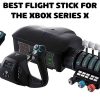If you’re in search of some new IEMs for gaming then you’ve come to the right place.
IEMs (In-Ear Monitors) have become increasingly popular with gamers in recent years. Compared to a bulky headset, many prefer them for their lightweight form that’s free of any clamping force.
Moreover, as they were originally designed for musicians, the audio they produce isn’t half-bad either, even at entry-level price points.
In this post, we will cover the best IEMs for gaming right now.
What Is the Best IEM for Gaming?
9. BLON BL-07
Connectivity: Wired
Impedance: 16 Ω
Sensitivity: 115 dB
Frequency range: 20 Hz – 20 KHz
Weight: 0.46 oz. (each)
The BL-07 is a single dynamic driver IEM from the company that brought us the highly acclaimed BL-03. Aesthetically, it has an interesting design with a metallic, geometric shell. This unique architecture houses a 10mm, fiber diaphragm driver capable of outputting high-resolution sound.
Constructed predominantly from zinc-plated metal, the BL-07 offers impressive build quality with only 0.46 ounces of weight (each). The 0.78mm braided silver cable feels nice as well, with shielding that runs all the way down. This prevents any tangles and softens the loop over your ear.
Due to being medium size, the BLON BL-07 should be a good fit (for most people). They don’t bury overly deep into the ear canal or protrude out too far either. Moreover, the fit offers decent comfort, especially when you find the right-size silicone ear-tip in the three included pairs.
In terms of sound, the BL-07 has a similar sound signature to the BL-03, but with more recessed mid-tones and warmer lows. The lows are the star of the show here, reaching deep sub-bass and thick mid-bass. In comparison to its older brother, the bass has less bloat and is not quite as dark.
As for the mids, these are slightly shallower than the BL-03 but still clear. Micro-details such as footsteps and minor cues are accurate enough and the imaging is good. As a result, you have a well-rounded, budget IEM that is not only good for open-world games but also FPS shooters.
Prices pulled from the Amazon Product Advertising API on:
Product prices and availability are accurate as of the date/time indicated and are subject to change. Any price and availability information displayed on [relevant Amazon Site(s), as applicable] at the time of purchase will apply to the purchase of this product.
8. KZ Zax
Connectivity: Wired
Impedance: 24 Ω
Sensitivity: 113 dB
Frequency range: 10 Hz – 40 KHz
Weight: 0.23 oz. (each)
The Zax is a radical departure from its predecessors in that KZ decided to go with a serious upgrade without any real high, monetary demand. What they came up with is a 16-unit (1 x 10mm DD + 7-x BA driver) masterpiece that’s small enough to fit into each ear.
In terms of the design, the Zax has a sleek aesthetic with a zinc-alloy vented faceplate capped over a transparent, blue plastic shell. These moldings then snap into a silver-plated cable encased in transparent silicone. Additionally, each bud has a 2-pin connector that sticks out from the body.
Due to being half the weight of the BLON BL07s, the KZ Zax does feel noticeably lighter in your ear. Fortunately, the cable is lightweight too, so there is no awkward, downward pull. After curving the cables over your ears, the weight mostly disappears.
Much like the BL-07, the low-end bass is quite deep. The bass sort of falls off at higher levels though, but the general beefiness never departs. Admittedly, the mids are a little flat and weak. However, the treble is bright, noticeable, and yields a lot of detail throughout the listening experience.
All in all, the Zax is a clear and powerful, high clarity IEM that’s worth the price.
Prices pulled from the Amazon Product Advertising API on:
Product prices and availability are accurate as of the date/time indicated and are subject to change. Any price and availability information displayed on [relevant Amazon Site(s), as applicable] at the time of purchase will apply to the purchase of this product.
7. TINHIFI T3 Plus
Connectivity: Wired
Impedance: 32 Ω
Sensitivity: 105 dB
Frequency range: 10 Hz – 20 KHz
Weight: 0.21 oz. (each)
While the previous two IEMs sport a techy aesthetic, the T3 Plus heads in the opposite direction with an artistic, marbled texture that conjures smoky blacks and greys. This attractive chassis design houses a high-performance 10mm driver with a liquid crystal, vibration-killing diaphragm.
3D printed from environmental resin, the T3 Plus has a hardy and durable shell that doesn’t damage easily. As for the cable, this is a 4-wire twist braid that’s soft to touch and reminds us of the ALO Audio Litz cable. It’s not thin or prone to fraying, but admittedly, it is prone to tangling.
Designed for ergonomics and comfort, the T3 Plus fits smoothly in the ear cavity and feels non-restrictive. Additionally, we like that the earbuds aren’t overly heavy. As a result, you can wear them for long periods without suffering from ear fatigue and loss of circulation on the surface of the skin.
In terms of audio, the T3 Plus has a mild V-shape signature with a fun bass response and a slight upper treble boost. It doesn’t have the best bass in its class but there’s no roll-off or bleed. We also like that the mid-range balances pleasantly against the bass elevation, and while the treble is there, it’s clear, but never bright or sibilant.
Overall, the Tin T3 Plus offers incredible value and provides a fabulous well-rounded package.
Prices pulled from the Amazon Product Advertising API on:
Product prices and availability are accurate as of the date/time indicated and are subject to change. Any price and availability information displayed on [relevant Amazon Site(s), as applicable] at the time of purchase will apply to the purchase of this product.
6. TRN VX Pro
Connectivity: Wired
Impedance: 22 Ω
Sensitivity: 106 dB
Frequency range: 7 Hz – 40 KHz
Weight: 0.23 oz. (each)
The TRN VX Pro is a hybrid flagship monitor retailing for less than $100. It boasts a 10mm, dual-magnet dynamic driver, along with a +8 balanced armature driver in each earpiece. Moreover, to improve the smoothness of the sound, it features a carbon, nanotube diaphragm.
The TRN VX Pro has an incredibly simple yet pleasing aesthetic design. Thanks to its full-metallic metal shell with tasteful chamfer lines, you have a clean, elegant look that doesn’t try to stand out. The entire shell is solid through and through except where it connects to the wire cable.
The wire cable wraps around the ear for a more ergonomic and weight-relieving fit. When combined with its reasonably sized nozzle, it slots in your ear seamlessly. Unfortunately, the sound isolation is quite poor though. As a result, you will hear cars passing by if you use them on the move.
Compared to last year’s set, the sound signature is a mild V-shape that benefits from some additional bass and a slight decrease in lower treble. Despite lowering the treble to help reduce fatigue, the emphasis is still mostly there, which some people are going to like.
As for the mids, these are lean, bright, and instruments in the upper mids will get your attention. However, the low-end is where the TRN VX Pro truly soars, with tight bass that is not overpowering.
Overall, what you’re looking at is a bright and detailed IEM that does well to separate all the frequencies among the in-game chaos.
Prices pulled from the Amazon Product Advertising API on:
Product prices and availability are accurate as of the date/time indicated and are subject to change. Any price and availability information displayed on [relevant Amazon Site(s), as applicable] at the time of purchase will apply to the purchase of this product.
5. Moondrop Aria
Connectivity: Wired
Impedance: 32 Ω
Sensitivity: 122 dB
Frequency range: 5 Hz – 36 KHz
Weight: 0.35 oz. (each)
The Moondrop Aria exploded onto the scene early last year to a chorus of outstanding reviews. Sporting a 10mm high-performance dynamic driver, a liquid crystal diaphragm, and an exceptionally fine voice coil that provides natural sounds, it’s easy to see why.
The Aria is matte black in its appearance, with streaks of fine gold running across it in straight patterns. It’s a classy and extravagant look that almost appears as if it caught the tail end of a paint spill. The cord is black as well and connects to the 2-pin connectors in each earpiece.
With the Aria, you’re getting a medium-size IEM that’s not too bulky or small. The ergonomic design and the slight build of the inner casing results in a lightweight fit that rests easily in the ears. Moreover, thanks to the short nozzle, they don’t punish the ear canal upon pushing them in, either.
We would describe the soundstage of the Aria as holographic. This is a very cone-shaped soundstage that wraps around to the back of your ears, providing a good sense of height. By filling the vertical space, you have an impression that the soundstage is slightly better/ bigger than usual.
The sound signature is mostly neutral, though leaning on the warmer end of the spectrum. You still get plenty of mids and treble-detail sparkles without it becoming painful. Moreover, while the bass is present, these are not for bass-heads. It has some thump but it’s more controlled.
Currently, the Aria is our best value IEM for gaming. Thanks to its solid sound stage and imaging, you’ll have no issues pinpointing opponents in a competitive game with this choice. They set the standard in this price range and provide a great first-time user experience.
Prices pulled from the Amazon Product Advertising API on:
Product prices and availability are accurate as of the date/time indicated and are subject to change. Any price and availability information displayed on [relevant Amazon Site(s), as applicable] at the time of purchase will apply to the purchase of this product.
4. IKKO OH10
Connectivity: Wired
Impedance: 18 Ω
Sensitivity: 106 dB
Frequency range: 20 Hz – 40 KHz
Weight: 0.21 oz. (each)
Debuting at $199, the IKKO OH10 takes things up another notch. For that price, you’re getting a sleek design with a powerful driver within. This is a 10mm, Knowles 33518 single-dynamic balanced driver capable of 106 dB and a 20 Hz – 40 kHz frequency range.
We especially like the OH10s copper-cavity-shell that gives off a liquid metal vibe. Under bright light, this results in a stunning chrome blue shine. Additionally, the 2-pin connectors throw a sharp, red contrast to the rest of the body, whether it’s the blue or black metallic chrome version of this IEM.
The size of the IKKO OH10 is a bit large and heavy, but this helps them to stick in your ear. Despite this, they are still comfortable to wear. The earpiece nozzle doesn’t jut out extensively and the braided cable runs into a short, silicone sleeve that slides smoothly over the ears.
Compared to the other IEMs on this list, the OH10 has one of the most emphasized bass frequencies – but without it being too overwhelmingly powerful. Naturally, this results in plenty of immersion, especially for games like Battlefield where everything is echoing and exploding around you.
The mid-tones can be a little thin at times but they remain boisterous and vibrant, and the treble extends well on the highs-ends. For this reason, you have a wonderful IEM for epic-type games that’s able to immerse you deep into the environment.
Prices pulled from the Amazon Product Advertising API on:
Product prices and availability are accurate as of the date/time indicated and are subject to change. Any price and availability information displayed on [relevant Amazon Site(s), as applicable] at the time of purchase will apply to the purchase of this product.
3. 7HZ Timeless
Connectivity: Wired
Impedance: 14.8 Ω
Sensitivity: 104 dB
Frequency range: 5 – 40 KHz
Weight: 0.19 oz.
The 7Hz Timeless is one of the hottest-selling planar IEMs right now for its sound quality and price/ performance value. Equipped with an ultra-thin diaphragm and a 14.2mm driver, it provides an ultra-fast response and an excellent dynamic range.
Machined out of a single piece of aviation-grade aluminum, the 7HZ Timeless has a lightweight shell that remains durable and wear-resistant. For ease of use, the package comes with a detachable MMCX cable. This is available in either a 3.5mm or a 4.4mm termination.
The design of the 7Hz has a huge faceplate that resembles a circular, disc-like configuration. Attached to this is an oddly shaped nozzle that separates from the rest of the shell. The nozzle is a little on the shorter side, therefore it doesn’t protrude too deeply into the ear.
Although the 7Hz may look to have a heavy and peculiar fit, surprisingly they do not. Despite their odd shape, they are relatively comfortable, particularly for larger ears. The large faceplate sits outside the ear and holds its position well. As a result, you can wear them safely for long periods.
The equally large planar magnetic driver means that the 7HZ Timeless has a unique neutral sound signature with exaggerated bass. The bass sounds fairly tight and punchy, however, it doesn’t take away from the mid or upper range at all, having a detailed midrange and bright highs.
It’s worth noting that the Timeless do require more current to reach their full potential. After we hooked them up to a pre-amp, that’s when their audio prowess really began to shine. Currently, the 7HZ Timeless is the best planar IEM for gaming, providing great technicality and clarity.
Prices pulled from the Amazon Product Advertising API on:
Product prices and availability are accurate as of the date/time indicated and are subject to change. Any price and availability information displayed on [relevant Amazon Site(s), as applicable] at the time of purchase will apply to the purchase of this product.
2. FiiO FD7
Connectivity: Wired
Impedance: 50 Ω
Sensitivity: 111 dB
Frequency range: 10 Hz – 40 KHz
Weight: 0.39 oz. (each)
The FD7 is FiiOs flagship IEM featuring pure-beryllium 12mm diaphragm dynamic drivers and a semi-open acoustic design. It comes standard with a monocrystalline silver cable, stainless steel MMCX connectors, and three types of interchangeable tubes that enable you to find your perfect sound.
As you might expect with a pair of IEMs at this price point, the build quality is top-tier. A solid, stainless steel chassis houses the internals – which is heavier than most but will ultimately stand the test of time. Moreover, the Litz-style braided cable is tough and has plenty of strength.
We especially like that the cable handles well, and doesn’t feel too thick in your hand. Another neat thing about the cable is that the end integrates a clever twist-lock mechanism. Due to this, it’s a breeze to change between different plugs sizes (2.5/ 3.5/ 4.4mm) quickly and efficiently.
Besides the cable, a big selling point over the previous model is that the FD7 now features pure beryllium drivers. This helps lower the distortion while achieving a higher transient response and greater sound control. As a result, the performance of this next-gen model goes one step beyond.
Unlike the FD5 which has a classic V-shape tuning, the FD7 is more balanced. In particular, the bass of the FD7 decays faster and has more control (rather than reaching lower sub-bass). Additionally, the mid-tones of the FD7 are better, having a fuller body of sound with higher resolution and clarity.
Despite being a balanced driver, the FD7 does not make sharp or painful sounds like some other BA IEMs do. Instead, the highs are smoother and less fatiguing for long-term usage. This makes the sound more comfortable, which is ideal for those for who love their extended gaming sessions.
Finally, on the topic of comfort, the FD7 has a similar ergonomic shape to many other single dynamic driver IEMs. They push ergonomically into the ear and feel less obnoxious over time. The large selection of included interchangeable ear channels also makes them easier to “tailor the fit”.
Currently, the FD5 has one of the best soundstage performances of all IEMs under $1000. It offers a stellar bass response and outstanding technical ability.
Prices pulled from the Amazon Product Advertising API on:
Product prices and availability are accurate as of the date/time indicated and are subject to change. Any price and availability information displayed on [relevant Amazon Site(s), as applicable] at the time of purchase will apply to the purchase of this product.
1. Sennheiser IE 600
Connectivity: Wired
Impedance: 18 Ω
Sensitivity: 94 dB
Frequency range: 4 Hz – 46.5 KHz
Weight: 0.21 oz. (each)
The Sennheiser IE600 is a single dynamic driver IEM that combines meticulous craftsmanship and exquisitely neutral sound. While its price sits between the flagship IE900 and entry-level IE300, its quality far exceeds both, along with many other top-tier IEMs available right now.
3D-printed from an amorphous metal alloy, the IE 600 shell is extremely robust and extraordinarily resistant to corrosion and scratches. Aesthetically, it has an almost cast-iron textured look with recessed pitting. Although it may not be the most flashy, its durability is sure to last you a lifetime.
The design of the IE600 is relatively low profile, which makes them very comfortable to wear. In particular, their compact size fits snuggly in your ears without the pitting of the casting feeling too harsh. Moreover, due to their space-grade material, they are surprisingly light, at just 0.21 oz. each.
Packed in each shell is a 7mm TrueResponse dynamic driver. These deliver an extra-wide 4 Hz – 46.5 kHz frequency response at 18 ohms of impedance. Unlike most other dynamic drivers IEMs, It’s a driver eye that’s well-tuned and gets plenty loud enough without any additional drive.
In terms of audio, you’re looking at a U-shaped signature that trends towards bright neutral. Expect powerful yet controlled sub-bass, detailed upper mids, and highly extended (and somewhat spicy) treble. Although the treble is energetic and delightful, it might be a touch sparkly for some people.
Despite having a slight bump, the bass is fast, accurate but not too overbearing. Furthermore, the separation is clear allowing you to easily distinguish between subtle directional cues on the battlefield. All this adds together to make an IEM that sounds straight-up enjoyable and immersive.
Overall, thanks to their superb materials, excellent comfort, and wonderful sound/ sound signature, the Sennheiser IE600 comes out on top as our best IEM for gaming. Those who have the money to spend will want to get their hands on this highly-rated product.

Are IEM good for gaming?
There’s little doubt that while gaming can be a blast, it’s only truly idyllic when there’s immersive sound. Multiple headsets have done well to achieve this in the past, however, for those put off by the weight and clamping force, an IEM (In-Ear Monitor) is another excellent option.
Besides being lightweight and comfortable, one of the greatest benefits of IEMs is their sound isolation abilities. Sound isolation is difficult to find with gaming headsets, at least for a true level of sound isolation. Generally, IEMs don’t “leak” sound nearly as much.
IEMs are capable of creating a more intimate gaming experience with greater immersion than many other peripherals. The level of comfort, simplicity, and detailed sound that IEMs bring to the table makes them a welcome addition to your gaming inventory.
They are also surprisingly affordable. IEMs are huge in the music industry, yet they often cost less than high-end gaming headsets or true-wireless earbuds. Although their price ranges, budget IEMs can still sound surprisingly good. This is because they focus on audio, rather than tons of features.
How to Choose the Best IEM for Gaming in 2024
Fortunately, it’s not difficult to find the best IEMs that will improve your gaming experience. Comfort levels are nearly universal while much of your focus should be on the sound experience, how well build quality, noise isolation, frequency, and their level of affordability.
Comfort
IEMs truly shine in terms of comfort. The fact that you can choose your silicone tip size already sets IEMs apart. Your primary focus should still be on the fit of the individual earpieces since this can make or break an IEM. Additionally, too much weight can create in-ear fatigue.
Audio Quality
EQ, soundstage, and imaging are some of the main factors you should look for in an IEM. You want an IEM that creates a more intimate experience so quality bass with lows and detailed mid-tones is a must. Better imaging will help with directional cues. Moreover, a wider soundstage can create a greater sense of immersion in large in-game environments.
Build Quality
It’s not difficult to find an affordable option with IEMs, however, be careful when you go too low in cost because cheaper IEMs sometimes cut corners in the manufacturing process.
Sound Signature
Sound signature refers to the characteristics of a device’s sound, relating to how it amplifies or reduces different frequencies.
For competitive gaming, an IEM with a flat sound signature will help bring out details in the mid-tones e.g. footsteps, and directional cues. Whereas a “V” shape signature with greater bass and treble can provide a more immersive experience in open-world genre games.
Noise Isolation
Some IEMs feature “noise canceling” technology, which shouldn’t be confused with noise isolation. For the best experience, you want both noise isolation (created from the earpiece’s ability to seal in your ear). Unlike earbuds, IEMSs are less likely to have noise-canceling (which uses microphones to emit soundwaves that are opposite of incoming noise).
Frequency
Anything below 15Hz means that the bass level is losing audibility and is felt more than heard, while anything over 20,000Hz is getting outside of our ability to hear it. It’s also difficult to associate a frequency with sound quality because everyone’s ears are different. If you have an opportunity to test them out before buying, take advantage of it.
Budget
Fortunately, IEMs are very budget-friendly. Even those on the low end are going to provide you with a great gaming experience. That’s the joy of shopping for IEMs. You have a lot of freedom to choose between a wide range of costs.
We hope you found an IEM for gaming on this list.
Click here for the 12 best Earbuds for the PS5
Click here for the best Earbuds for the Xbox Series X
Image credit:
Photo by Vitor Machado on Unsplash


















